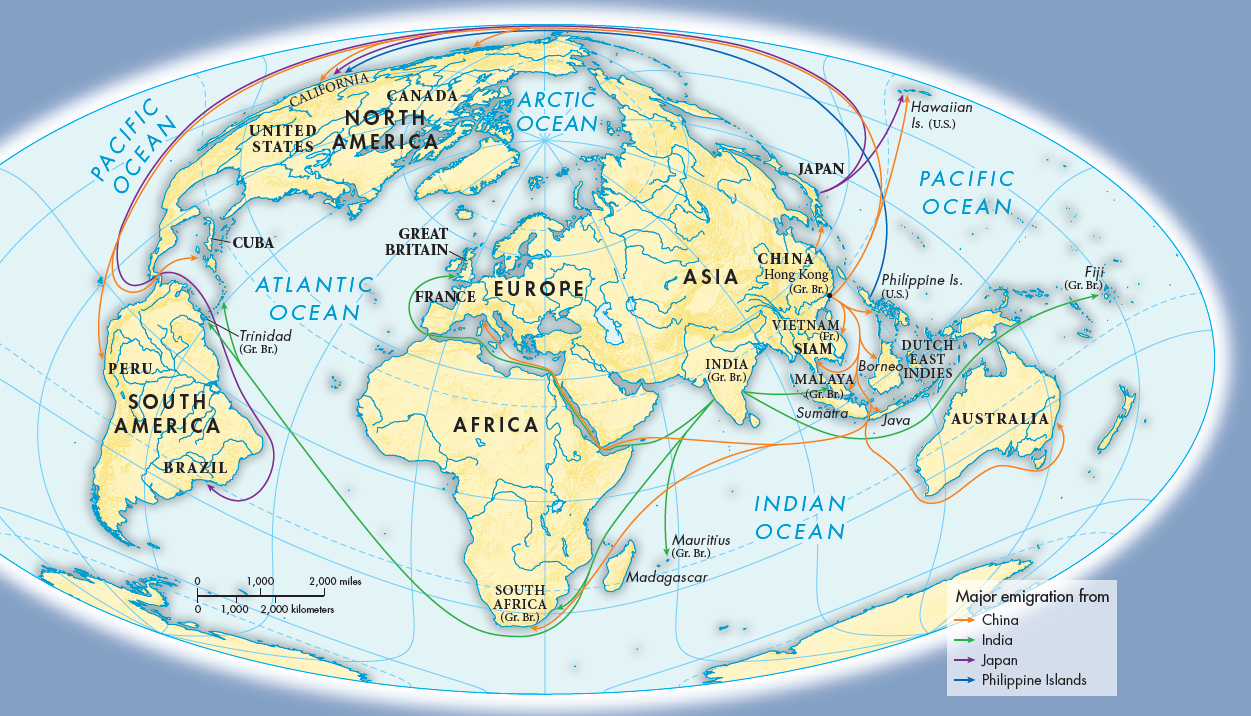Understanding World Societies:
Printed Page 802
Asian Emigration
Like Europeans, Asians left their native countries in unprecedented numbers in the nineteenth century (Map 26.3). As in Europe, both push and pull factors prompted people to leave home. China and India were extremely densely populated countries — China with more than 400 million people in the mid-

By the nineteenth century the Chinese formed key components of mercantile communities throughout Southeast Asia. Chinese often assimilated in Siam and Vietnam, but they rarely did so in Muslim areas such as Java, Catholic areas such as the Philippines, and primitive tribal areas such as northern Borneo. In these places distinct Chinese communities emerged.
With the growth in trade that accompanied the European imperial expansion, Chinese began to settle in the islands of Southeast Asia in larger numbers. After Singapore was founded by the British in 1819, Chinese rapidly poured in, soon becoming the dominant ethnic group. In British-
Discovery of gold in California in 1848, Australia in 1851, and Canada in 1858 encouraged Chinese to book passage to those places. In California few arrived soon enough to strike gold, but thousands found work building railroads, and others took up mining in Wyoming and Idaho.
Indian entrepreneurs were similarly attracted by the burgeoning commerce of the growing British Empire. The bulk of Indian emigrants were indentured laborers, recruited under contract. The rise of indentured labor from Asia was a direct result of the outlawing of the African slave trade in the early nineteenth century by Britain and the United States. Sugar plantations in the Caribbean and elsewhere needed new sources of workers, and planters in the British colonies discovered that they could recruit Indian laborers to replace blacks. After the French abolished slavery in 1848, they recruited workers from India as well. Later in the century many Indians emigrated to British colonies in Africa, the largest numbers to South Africa.
Indentured laborers secured as substitutes for slaves were often treated little better than slaves. In response to such abuse, the Indian colonial government established regulations stipulating a maximum indenture period of five years, after which the migrant would be entitled to passage home. Even though government “protectors” were appointed at the ports of embarkation, exploitation of indentured workers continued largely unchecked.
In areas outside the British Empire, China offered the largest supply of ready labor. Starting in the 1840s contractors arrived at Chinese ports to recruit labor for plantations and mines in Cuba, Peru, Hawaii, Sumatra, South Africa, and elsewhere. Chinese laborers did not have the British government to protect them and seem to have suffered even more than Indian workers.
India and China sent more people abroad than any other Asian countries during this period, but they were not alone. As Japan started to industrialize, its cities could not absorb all those forced off the farms, and people began emigrating in significant numbers, many to Hawaii and later to South America. Emigration from the Philippines also was substantial, especially after it became a U.S. territory in 1898.

This certificate proved that the eleven-
Asian migration to the United States, Canada, and Australia would undoubtedly have been greater if it had not been so vigorously resisted by the white settlers in those regions. In 1882 Chinese were barred from becoming American citizens, and the immigration of Chinese laborers was suspended. Australia also put a stop to Asian immigration with the Commonwealth Immigration Restriction Act of 1901, which established the “white Australia policy” that remained on the books until the 1970s.
Most of the Asian migrants discussed so far were illiterate peasants or business people, not members of traditional educated elites. By the beginning of the twentieth century, however, another group of Asians was going abroad in significant numbers: students. Most of these students traveled abroad to learn about Western science, law, and government in the hope of strengthening their own countries. On their return they contributed enormously to the intellectual life of their societies, increasing understanding of the modern Western world and also becoming the most vocal advocates of overthrowing the old order and driving out the colonial masters.
Among the most notable of these foreign-
>QUICK REVIEW
Why did so many Asians migrate during this period? Where did they most often go?